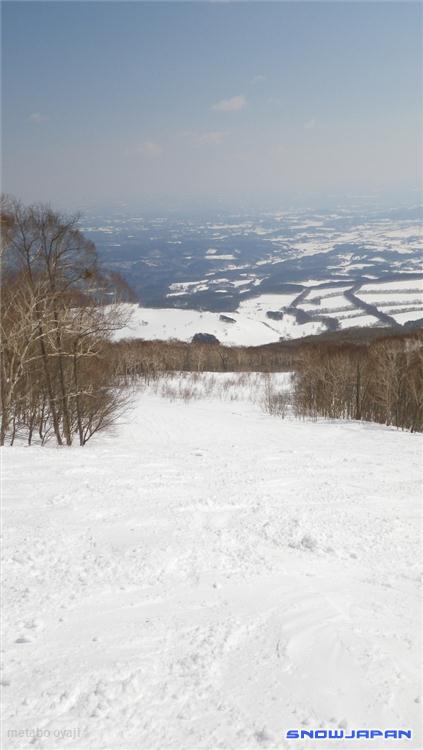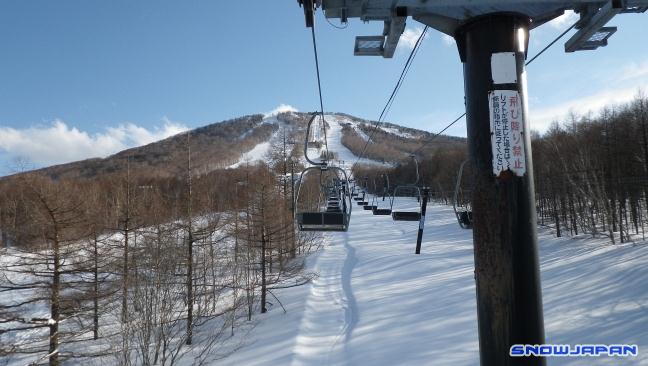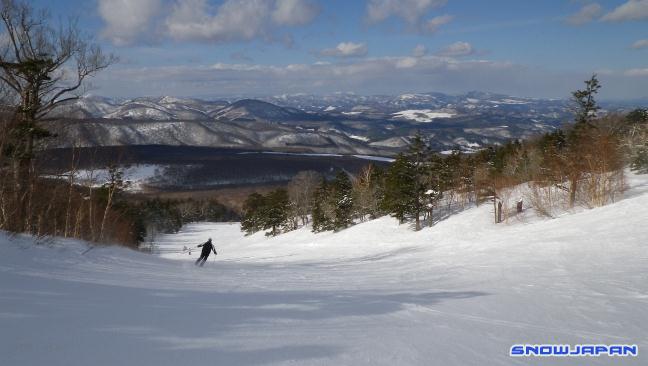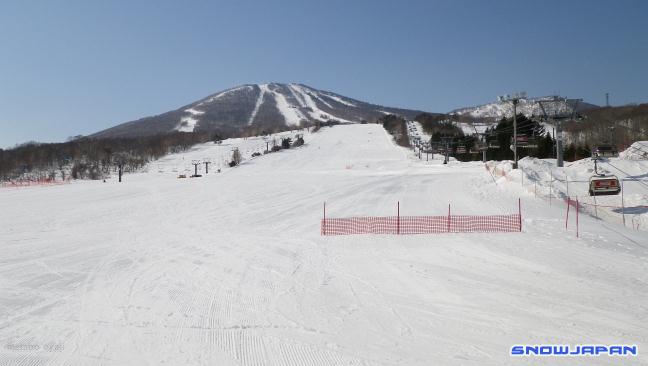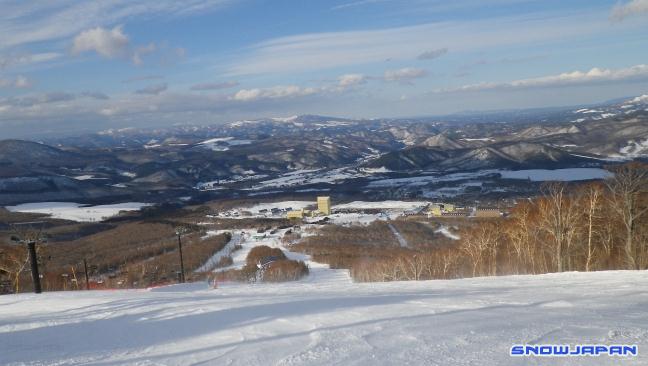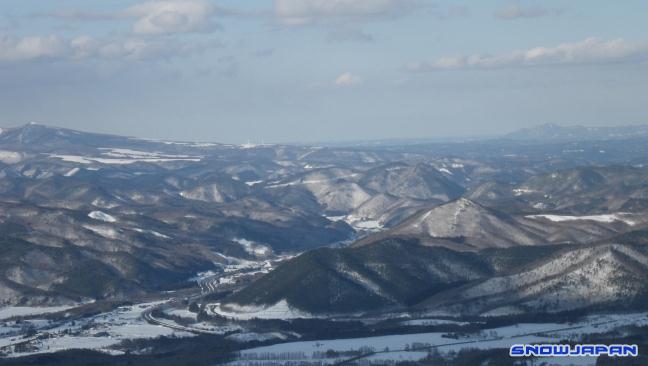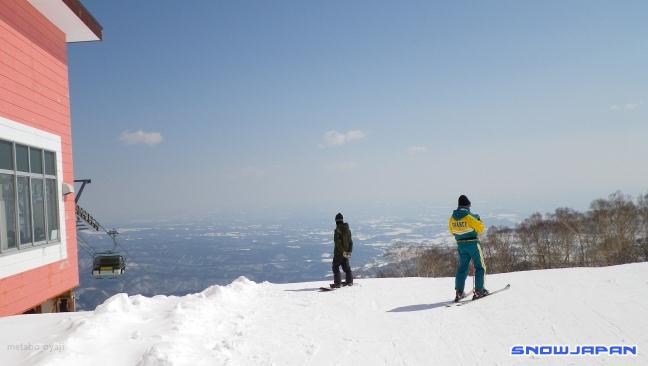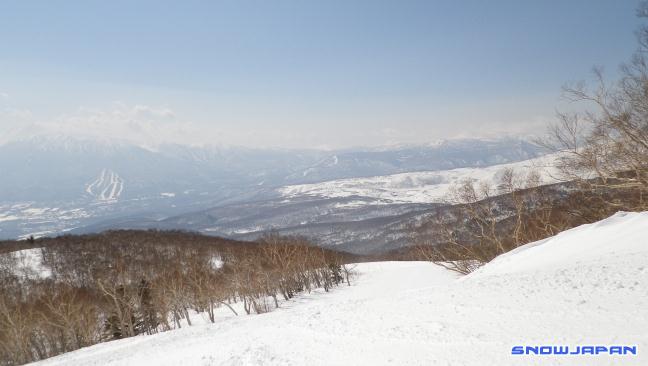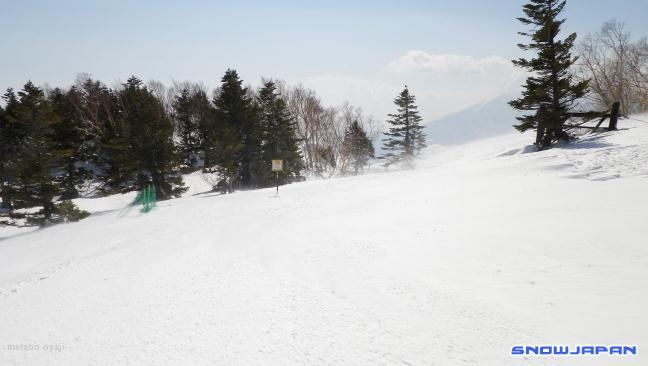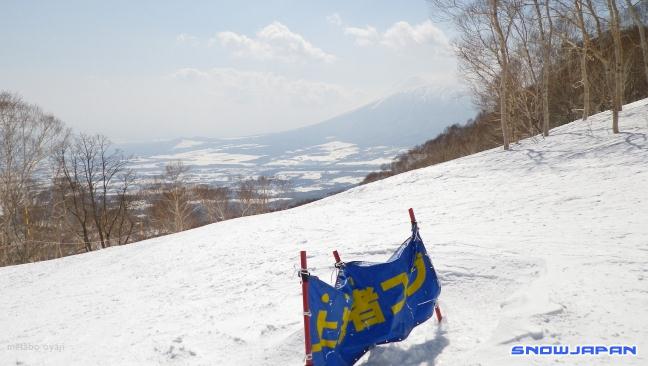Appi Kogen, Iwate
Visited Appi Kogen for the first time. Late March, following a snowfall; the weather changed during our stay from from winter to pure spring conditions.
The ski area is mostly arrayed around the peak of Maemoriyama. The main base area is at the bottom of the Central Gelaende, with the Sailer Gelaende to looker's left of that, and the Second Gelaende to the left of Sailer. To looker's right of the Central Gelaende is a single lift going up the adjacent Nishimoriyama.
One feature of this ski area is a skier-only zone between the Central Gelaende and the Nishimori Gelaende. A skier-only T-bar and chair lift serve a couple of skier-only trails.
The first day we just had the afternoon on-hill, after a 6-hour drive, so just tried to get the lay of the land. Up the gondola to the top, and down the easy Yamabato course to the bottom. The Nishimori lift, reachable from that course, was running, but we didn't go up it. Also parallel to the main gondola are a series of chair lifts. The runs grow gradually steeper from the bottom to the top, maxing out in the low 30s degrees at the top.
The next day, The Kid wanted to take lessons all day, which gave me a chance to roam a bit more freely. I started off by heading over the Second Gelaende side from the top, and worked my around. Up top, some powder was still being blown around in the wind in the morning. Over on the Second Gelaende side was some sun-softened corduroy runs, and a soft-snow mogul run. Off the bottom of the mogul run is a closed run with new trees growing in it, that used to lead down to what seems to be an abandoned lift at the bottom, in an area that must have originally been planned to be a major secondary base area. Now the only lift running on this side of the mountain is a quad running from above the abandoned bunny slope, to 2/3 of the way up the Second Gelaende side.
Did a couple laps of the mogul run and subsequent corduroy, then decided to head over the the Sailer area, taking the lower renraku course over. Only to discover that the Sailer gondola was not running! Nor were any of the other chairs in that area except for the mid-mountain pair lift, a very slow romance lift. Riding that lift up, I decided to head back to the Central area, and explore in the other direction.
The Nishimori lift was closed that day due to mechanical problems, so I decided to check out the skier-only areas. Taking the main gondola back to the top of the mountain, the drop-in to that area is the top of the Ootaka course, a hard-mogul course with wind-blown powder drifts. Quite nice, actually. Then over to the skier-only Kitsutsuki and Kakkou courses, which start at the top of the T-bar. To be honest, I couldn't see what was so special about them, except that they still had fresh corduroy patches mid-afternoon.
The more notable feature of the skier-only areas is the T-bar. I hadn't ridden a T-bar in probably 40 years. Natsukashii! In addition to the t-bar, there is also a Poma lift, though it was not running while were there. Who the heck runs T-bars and Poma lifts in this day and age??
Actually, I have to admit that the T-bar became one of my favorite lifts later, giving access to the upper reaches of the Ootaka course when the upper chair lift (Chair 4 of the Central area) was closed. (Though of course I could only ride it when my snowboarding kid was not in tow.)
Near the end of the day I dropped back into the Sailer side to try the steepest course on the mountain, the 34-degree mogul course. Hard-frozen, bulletproof, huge ice moguls in the top part of the course. I would say my favorite mogul course that day was upper Ootaka, followed by the Second side course, with the Sailer course following in distant third. On the bright side, at the bottom of the Sailer ice-mogul bahn was a corduroy runout, almost untouched still at 3:00 in the afternoon. Not many people running that course that day, it would seem.
The third day was warm and windy. So windy that the top of the mountain was never accessible. The kid wanted to practice boarding lessons from the previous day, so we mostly looped on the #3 chair lift on the Central side, serving the intermediate section of the Hayabusa and Ootaka courses. We did try to visit the Sailer side once via the Sailer renraku lift, and immediately regretted going to lower elevations where the snow quickly turned to glue. The order of the day was to stay as high as possible on the mountain as possible to avoid the glue-like lower conditions. Unfortunately, around lunch time the #3 chair lift was closed due to wind, so we were driven to the base area for lunch.
Long lunch, and the kid decided to save what could be saved of the day by taking a 1-hour beginner's park lesson, which started at 2:00. At which time also the rain started... but the kid was determined to go through with it. So, off I went to loop the t-bar for the next hour, while the kid studied guratori. Fortunately, the rain only lasted about 15 minutes, and by the time the kid's lesson was over, the #3 chair was open again, so we finished out the day by looping that chair again. It was getting pretty windy up there again, and I almost felt that they should have shut that lift, but were keeping it running out of sympathy for those of us who had stuck through the day.
The fourth day was warm again, but there was no wind, and all lifts were running. Perfect spring conditions in the upper half of the mountain, impassable glue on the lower half of the mountain. Fortunately, by this time, the kid was feeling confident enough to hit the topmost Hayabusa course (30 degrees), so we spent most of the day looping the topmost, #4 lift to the peak. Good soft, but not slushy, spring skiing conditions up there.
At one point I broke away to hit the Nishimori lift, since it was finally running and accessible. Unfortunately the snow in the lower half of the Nishomori Gelaende was sticky glue... but I could see that on a powder day this slope would have nice terrain and on-course treed areas. We also tried going down the Sailer side, intending to ride the Sailer gondola back up, but the snow started turning to glue halfway down, so we abandoned that plan and took the Sailer quad back to the top.
Following that, we looped the top couple of chairs on the Central side until our legs gave out, then hit the road for the 6-hour drive home.
Impressions: It is a big, conical, bubble-era resort, with a large, well-connected area. Not the most imaginative of layouts, to be honest, but enough there to keep one amused for a few days. In winter, when it is all in good condition, it should be a great place to go touring around. In the less-than-ideal spring conditions while we were there, I did notice that they seem to work pretty hard to keep as much of the terrain going as possible. We (almost) always found some good bits to hit even on the challenging-weather days.
I should add that I was quite happy with the progress my kid made as a result of snowboarding lessons there, as of course was the kid. The instructors seem to be pretty good there.
One other thing I noticed: foreigners! I saw at least one or two other foreigners each day were were there. First day was a family from Misawa air base. The second day some ALTs from Aomori. The third day a couple of guys from I don't know where, and the 4th day a nice couple from Melbourne. Niseko it may not be, but seeing other foreigners apparently there as a matter of course (even if only a couple per day) was kind of a novel experience. Even had one of the resort staff try to speak English to me.
We stayed at Pension Mutti while there, a very nice pension run by a former ski instructor who apparently also spent some time in Austria. Importantly for us, it is pet-friendly – dogs are even welcome to accompany their families in the dining hall. At the end of our stay, our dog was given a custom “Mutti” dog biscuit as an edible souvenir.
![Posted Image]()
From top looking towards Nishimori slope:
![Posted Image]()
Second Gelaende side, looking down mogul course to permanently-closed course:
![Posted Image]()
![Posted Image]()
![Posted Image]()
![Posted Image]()
![Posted Image]()
![Posted Image]()
![Posted Image]()
![Posted Image]()
![Posted Image]()
![Posted Image]()
Visited Appi Kogen for the first time. Late March, following a snowfall; the weather changed during our stay from from winter to pure spring conditions.
The ski area is mostly arrayed around the peak of Maemoriyama. The main base area is at the bottom of the Central Gelaende, with the Sailer Gelaende to looker's left of that, and the Second Gelaende to the left of Sailer. To looker's right of the Central Gelaende is a single lift going up the adjacent Nishimoriyama.
One feature of this ski area is a skier-only zone between the Central Gelaende and the Nishimori Gelaende. A skier-only T-bar and chair lift serve a couple of skier-only trails.
The first day we just had the afternoon on-hill, after a 6-hour drive, so just tried to get the lay of the land. Up the gondola to the top, and down the easy Yamabato course to the bottom. The Nishimori lift, reachable from that course, was running, but we didn't go up it. Also parallel to the main gondola are a series of chair lifts. The runs grow gradually steeper from the bottom to the top, maxing out in the low 30s degrees at the top.
The next day, The Kid wanted to take lessons all day, which gave me a chance to roam a bit more freely. I started off by heading over the Second Gelaende side from the top, and worked my around. Up top, some powder was still being blown around in the wind in the morning. Over on the Second Gelaende side was some sun-softened corduroy runs, and a soft-snow mogul run. Off the bottom of the mogul run is a closed run with new trees growing in it, that used to lead down to what seems to be an abandoned lift at the bottom, in an area that must have originally been planned to be a major secondary base area. Now the only lift running on this side of the mountain is a quad running from above the abandoned bunny slope, to 2/3 of the way up the Second Gelaende side.
Did a couple laps of the mogul run and subsequent corduroy, then decided to head over the the Sailer area, taking the lower renraku course over. Only to discover that the Sailer gondola was not running! Nor were any of the other chairs in that area except for the mid-mountain pair lift, a very slow romance lift. Riding that lift up, I decided to head back to the Central area, and explore in the other direction.
The Nishimori lift was closed that day due to mechanical problems, so I decided to check out the skier-only areas. Taking the main gondola back to the top of the mountain, the drop-in to that area is the top of the Ootaka course, a hard-mogul course with wind-blown powder drifts. Quite nice, actually. Then over to the skier-only Kitsutsuki and Kakkou courses, which start at the top of the T-bar. To be honest, I couldn't see what was so special about them, except that they still had fresh corduroy patches mid-afternoon.
The more notable feature of the skier-only areas is the T-bar. I hadn't ridden a T-bar in probably 40 years. Natsukashii! In addition to the t-bar, there is also a Poma lift, though it was not running while were there. Who the heck runs T-bars and Poma lifts in this day and age??
Actually, I have to admit that the T-bar became one of my favorite lifts later, giving access to the upper reaches of the Ootaka course when the upper chair lift (Chair 4 of the Central area) was closed. (Though of course I could only ride it when my snowboarding kid was not in tow.)
Near the end of the day I dropped back into the Sailer side to try the steepest course on the mountain, the 34-degree mogul course. Hard-frozen, bulletproof, huge ice moguls in the top part of the course. I would say my favorite mogul course that day was upper Ootaka, followed by the Second side course, with the Sailer course following in distant third. On the bright side, at the bottom of the Sailer ice-mogul bahn was a corduroy runout, almost untouched still at 3:00 in the afternoon. Not many people running that course that day, it would seem.
The third day was warm and windy. So windy that the top of the mountain was never accessible. The kid wanted to practice boarding lessons from the previous day, so we mostly looped on the #3 chair lift on the Central side, serving the intermediate section of the Hayabusa and Ootaka courses. We did try to visit the Sailer side once via the Sailer renraku lift, and immediately regretted going to lower elevations where the snow quickly turned to glue. The order of the day was to stay as high as possible on the mountain as possible to avoid the glue-like lower conditions. Unfortunately, around lunch time the #3 chair lift was closed due to wind, so we were driven to the base area for lunch.
Long lunch, and the kid decided to save what could be saved of the day by taking a 1-hour beginner's park lesson, which started at 2:00. At which time also the rain started... but the kid was determined to go through with it. So, off I went to loop the t-bar for the next hour, while the kid studied guratori. Fortunately, the rain only lasted about 15 minutes, and by the time the kid's lesson was over, the #3 chair was open again, so we finished out the day by looping that chair again. It was getting pretty windy up there again, and I almost felt that they should have shut that lift, but were keeping it running out of sympathy for those of us who had stuck through the day.
The fourth day was warm again, but there was no wind, and all lifts were running. Perfect spring conditions in the upper half of the mountain, impassable glue on the lower half of the mountain. Fortunately, by this time, the kid was feeling confident enough to hit the topmost Hayabusa course (30 degrees), so we spent most of the day looping the topmost, #4 lift to the peak. Good soft, but not slushy, spring skiing conditions up there.
At one point I broke away to hit the Nishimori lift, since it was finally running and accessible. Unfortunately the snow in the lower half of the Nishomori Gelaende was sticky glue... but I could see that on a powder day this slope would have nice terrain and on-course treed areas. We also tried going down the Sailer side, intending to ride the Sailer gondola back up, but the snow started turning to glue halfway down, so we abandoned that plan and took the Sailer quad back to the top.
Following that, we looped the top couple of chairs on the Central side until our legs gave out, then hit the road for the 6-hour drive home.
Impressions: It is a big, conical, bubble-era resort, with a large, well-connected area. Not the most imaginative of layouts, to be honest, but enough there to keep one amused for a few days. In winter, when it is all in good condition, it should be a great place to go touring around. In the less-than-ideal spring conditions while we were there, I did notice that they seem to work pretty hard to keep as much of the terrain going as possible. We (almost) always found some good bits to hit even on the challenging-weather days.
I should add that I was quite happy with the progress my kid made as a result of snowboarding lessons there, as of course was the kid. The instructors seem to be pretty good there.
One other thing I noticed: foreigners! I saw at least one or two other foreigners each day were were there. First day was a family from Misawa air base. The second day some ALTs from Aomori. The third day a couple of guys from I don't know where, and the 4th day a nice couple from Melbourne. Niseko it may not be, but seeing other foreigners apparently there as a matter of course (even if only a couple per day) was kind of a novel experience. Even had one of the resort staff try to speak English to me.
We stayed at Pension Mutti while there, a very nice pension run by a former ski instructor who apparently also spent some time in Austria. Importantly for us, it is pet-friendly – dogs are even welcome to accompany their families in the dining hall. At the end of our stay, our dog was given a custom “Mutti” dog biscuit as an edible souvenir.
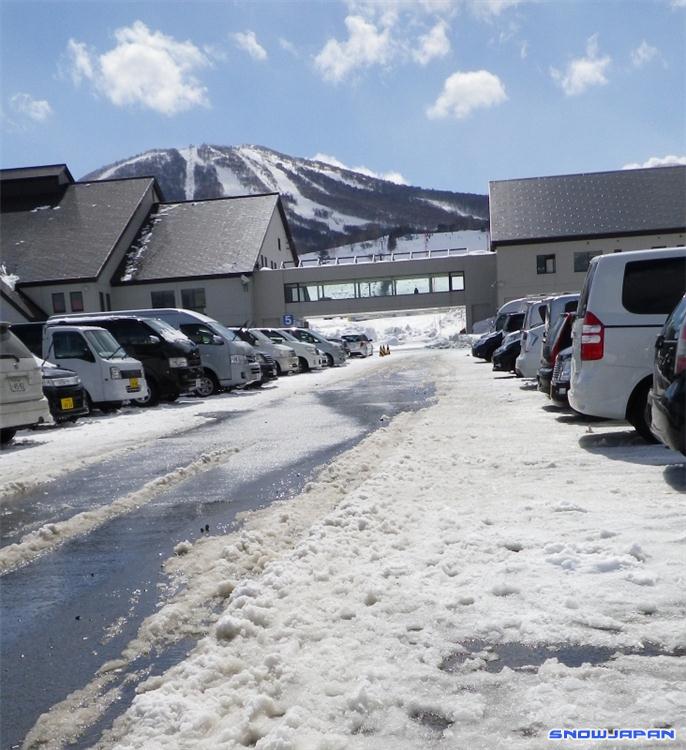
From top looking towards Nishimori slope:
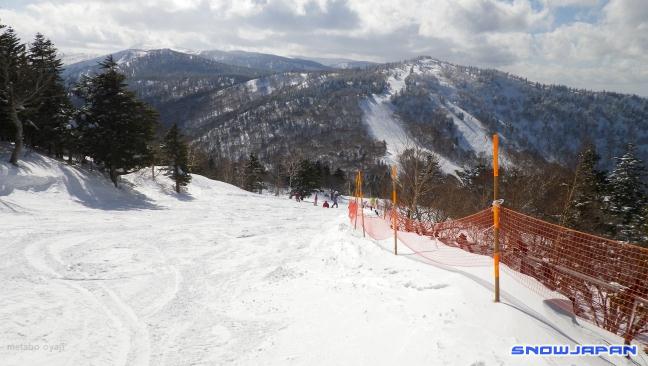
Second Gelaende side, looking down mogul course to permanently-closed course:
